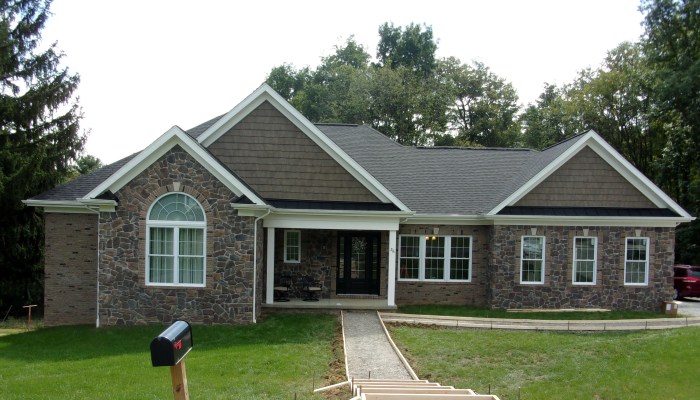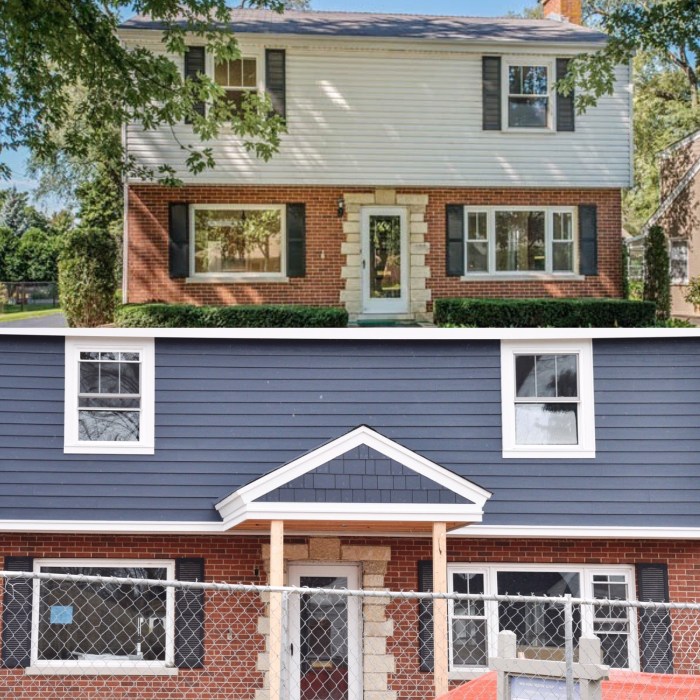Exploring the Beauty of Brick with Siding
Brick with siding combines the timeless elegance of brick with the versatility of siding, creating a harmonious blend that enhances the aesthetic appeal of any structure. From classic to modern styles, the combination of these two materials offers a unique design opportunity for architects and homeowners alike.
As we delve deeper into the world of brick with siding, we uncover the key aspects that make this architectural element a popular choice in construction projects.
Overview of Brick with Siding

Brick with siding is a popular construction technique that combines the durability and classic look of brick with the versatility and ease of maintenance of siding materials. The primary purpose of using brick with siding in construction is to create a visual aesthetic that is both traditional and modern, while also providing a sturdy and weather-resistant exterior for buildings.One of the key benefits of using brick with siding is the ability to customize the design and appearance of a structure.
By combining different types of brick and siding materials, architects and designers can create unique and eye-catching facades that stand out from traditional all-brick or all-siding buildings. Additionally, brick with siding offers enhanced insulation properties, helping to improve energy efficiency and reduce heating and cooling costs.Popular styles of brick with siding include combinations such as red brick with white vinyl siding, gray brick with cedar shake siding, or even a mix of brick veneer with metal panels.
These combinations allow for endless design possibilities, making brick with siding a versatile choice for residential and commercial construction projects.
Types of Siding Materials for Brick
When it comes to pairing siding materials with brick, there are several options available, each with its own set of characteristics and aesthetic appeal. Let's explore some common types of siding materials used with brick and how they compare.
Vinyl Siding
Vinyl siding is a popular choice due to its affordability and low maintenance requirements. When paired with brick, vinyl siding can provide a clean and modern look to the exterior of a building. However, it may not offer the same level of durability as other materials like fiber cement.
Fiber Cement Siding
Fiber cement siding is known for its durability and resistance to elements like fire, insects, and rot. When combined with brick, fiber cement siding can create a visually appealing contrast that adds depth and texture to the facade. It is a more premium option compared to vinyl siding.
Wood Siding
Wood siding offers a natural and traditional look that can complement the timeless appeal of brick. However, wood siding requires regular maintenance to prevent issues like rotting, warping, and insect damage. When paired with brick, wood siding can create a warm and inviting aesthetic.
Stone Veneer Siding
Stone veneer siding is a lightweight and cost-effective alternative to natural stone. When used alongside brick, stone veneer siding can enhance the exterior with a rustic and elegant appearance. It provides a high-end look without the hefty price tag of real stone.
Aluminum Siding
Aluminum siding is durable, lightweight, and resistant to rust and corrosion. When paired with brick, aluminum siding can offer a sleek and modern finish to the exterior. It is relatively low maintenance and can be painted in various colors to suit different design preferences.
Installation Process
Installing brick with siding involves several key steps to ensure a successful integration of both materials. It is essential to pay attention to detail and follow the proper techniques to achieve a seamless finish.
Preparation
- Ensure the surface where the brick and siding will be installed is clean and free of debris.
- Measure and mark the area to determine the layout of the brick and siding.
- Prepare the necessary tools and materials for the installation process.
Tools and Materials
- Brick and siding materials
- Hammer and nails
- Masonry saw
- Trowel
- Level
- Caulk gun
- Construction adhesive
Installation Steps
- Start by installing the brick according to the predetermined layout, using mortar to secure the bricks in place.
- Once the brick installation is complete, begin installing the siding, ensuring it aligns with the brickwork.
- Secure the siding in place using nails or construction adhesive, depending on the type of siding material.
- Use a level to ensure the siding is straight and properly aligned with the brick.
Tips for Seamless Integration
- Pay close attention to the alignment of the brick and siding to maintain a cohesive look.
- Use color-matching caulk to fill in any gaps between the brick and siding for a clean finish.
- Regularly check the level and adjust as needed to ensure a professional installation.
- Take your time during the installation process to avoid mistakes and achieve a high-quality result.
Maintenance and Care

Maintaining brick with siding is crucial to ensure its longevity and aesthetic appeal. Regular care and attention can prevent common issues and preserve the appearance of your home exterior.
Maintenance Requirements
- Inspect the siding and brick for any signs of damage, such as cracks, chipping, or discoloration.
- Check for any gaps or loose pieces that may allow moisture to seep in and cause potential damage.
- Clean the siding and brick regularly to remove dirt, debris, and mold buildup.
- Consider applying a protective sealant to the brick to enhance its durability and resistance to weathering.
Common Issues and Solutions
- Efflorescence: White, powdery deposits on the brick surface can be removed with a mild detergent and water solution.
- Mold and Mildew: Use a mixture of water and bleach to clean affected areas, and ensure proper ventilation to prevent regrowth.
- Cracks and Damage: Repair any cracks or damaged areas promptly to prevent water infiltration and further deterioration.
Cleaning and Preservation Tips
- Regularly wash the siding with a hose or pressure washer to remove dirt and grime.
- Avoid using harsh chemicals or abrasive materials that can damage the siding or brick surface.
- Consider hiring a professional for deep cleaning and maintenance tasks if needed.
Conclusive Thoughts
In conclusion, brick with siding not only provides durability and functionality but also adds a touch of sophistication to any building. Whether you prefer a traditional look or a contemporary feel, the versatility of brick with siding opens up a world of design possibilities.
Dive into the realm of brick with siding and transform your architectural vision into reality.
Q&A
What are the benefits of using brick with siding?
Brick with siding offers a unique blend of aesthetics, durability, and design flexibility that can enhance the overall look of a building.
What types of siding materials are commonly used with brick?
Common siding materials used with brick include vinyl, wood, fiber cement, and metal.
How can I ensure a seamless integration of brick and siding during installation?
Ensure proper alignment, use high-quality materials, and follow manufacturer guidelines for installation to achieve a seamless integration of brick with siding.
What maintenance practices are recommended for preserving the appearance of brick with siding?
Regular cleaning, inspections for damage, and timely repairs are key maintenance practices to preserve the appearance and longevity of brick with siding.




